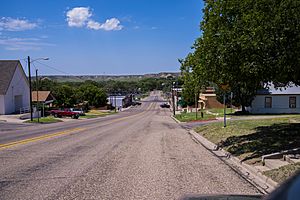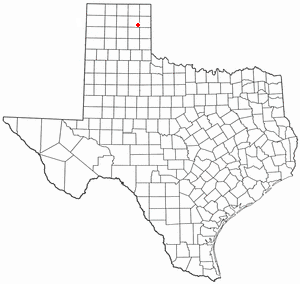Miami, Texas facts for kids
Quick facts for kids
Miami, Texas
|
|
|---|---|

Looking north through Miami along Main Street
|
|

Location of Miami, Texas
|
|
 |
|
| Country | United States |
| State | Texas |
| County | Roberts |
| Area | |
| • Total | 1.17 sq mi (3.03 km2) |
| • Land | 1.17 sq mi (3.03 km2) |
| • Water | 0.00 sq mi (0.00 km2) |
| Elevation | 2,736 ft (834 m) |
| Population
(2020)
|
|
| • Total | 539 |
| • Density | 460.7/sq mi (177.9/km2) |
| Time zone | UTC−6 (Central (CST)) |
| • Summer (DST) | UTC−5 (CDT) |
| ZIP code |
79059
|
| Area code(s) | 806 |
| FIPS code | 48-47988 |
| GNIS feature ID | 2411094 |
Miami (pronounced my-AM-uh) is a small city in Roberts County, Texas, United States. It is the only town in Roberts County and also serves as its county seat, which means it's where the main government offices for the county are located. In 2020, about 539 people lived there. Miami is part of the larger Pampa micropolitan area. This is a region that includes a main city and nearby smaller communities that are connected.
Contents
Discovering Miami, Texas
Miami is located in the Texas Panhandle, a flat part of Texas in the northern section of the state. The city covers an area of about 1.17 square miles (3.03 square kilometers). All of this area is land, with no major bodies of water. The city sits at an elevation of about 2,736 feet (834 meters) above sea level.
Population Changes Over Time
The number of people living in Miami has changed throughout its history.
| Historical population | |||
|---|---|---|---|
| Census | Pop. | %± | |
| 1920 | 935 | — | |
| 1930 | 953 | 1.9% | |
| 1940 | 713 | −25.2% | |
| 1950 | 646 | −9.4% | |
| 1960 | 656 | 1.5% | |
| 1970 | 611 | −6.9% | |
| 1980 | 813 | 33.1% | |
| 1990 | 675 | −17.0% | |
| 2000 | 588 | −12.9% | |
| 2010 | 597 | 1.5% | |
| 2020 | 539 | −9.7% | |
| U.S. Decennial Census 2020 Census |
|||
In 2020, the U.S. Census counted 539 people living in Miami. There were 197 households and 137 families in the city at that time. Most residents identified as White (Non-Hispanic), making up about 84.6% of the population. About 7.24% of the people were of Hispanic or Latino background.
Understanding Miami's Climate
| Climate data for Miami, Texas (1981–2010 normals) | |||||||||||||
|---|---|---|---|---|---|---|---|---|---|---|---|---|---|
| Month | Jan | Feb | Mar | Apr | May | Jun | Jul | Aug | Sep | Oct | Nov | Dec | Year |
| Record high °F (°C) | 83 (28) |
85 (29) |
92 (33) |
98 (37) |
103 (39) |
108 (42) |
107 (42) |
104 (40) |
104 (40) |
99 (37) |
88 (31) |
80 (27) |
108 (42) |
| Mean daily maximum °F (°C) | 49.0 (9.4) |
52.3 (11.3) |
60.6 (15.9) |
69.8 (21.0) |
78.1 (25.6) |
86.4 (30.2) |
91.4 (33.0) |
90.2 (32.3) |
82.4 (28.0) |
71.5 (21.9) |
59.5 (15.3) |
48.7 (9.3) |
69.9 (21.1) |
| Mean daily minimum °F (°C) | 23.1 (−4.9) |
26.0 (−3.3) |
32.9 (0.5) |
41.5 (5.3) |
51.9 (11.1) |
61.1 (16.2) |
66.1 (18.9) |
65.3 (18.5) |
57.0 (13.9) |
44.9 (7.2) |
33.0 (0.6) |
23.9 (−4.5) |
43.9 (6.6) |
| Record low °F (°C) | −4 (−20) |
−7 (−22) |
3 (−16) |
17 (−8) |
30 (−1) |
45 (7) |
51 (11) |
47 (8) |
31 (−1) |
12 (−11) |
8 (−13) |
−8 (−22) |
−8 (−22) |
| Average precipitation inches (mm) | 0.69 (18) |
0.70 (18) |
1.63 (41) |
2.04 (52) |
2.98 (76) |
3.64 (92) |
2.71 (69) |
2.77 (70) |
2.12 (54) |
2.01 (51) |
1.05 (27) |
0.88 (22) |
23.22 (590) |
| Average snowfall inches (cm) | 4.0 (10) |
3.8 (9.7) |
3.6 (9.1) |
0.9 (2.3) |
0.2 (0.51) |
0 (0) |
0 (0) |
0 (0) |
0 (0) |
0.1 (0.25) |
1.3 (3.3) |
5.1 (13) |
19 (48) |
| Source: National Weather Service | |||||||||||||
Miami, Texas, experiences a climate with warm summers and mild winters. The average high temperature in July, the hottest month, is around 91.4°F (33°C). In January, the coldest month, the average low temperature is about 23.1°F (-4.9°C). The area receives about 23.22 inches (590 mm) of rain each year. Snowfall is also common, with an average of 19 inches (48 cm) per year.
Education in Miami
Students in Miami attend schools within the Miami Independent School District. All grades, from prekindergarten through 12th grade, are taught in one main school building. This allows for a close-knit learning environment. The school also uses technology to help students learn. For example, Miami High School offers Spanish language classes to seven other schools in the area through the Texas Virtual School program. This program uses online tools to connect students with teachers.
See also
 In Spanish: Miami (Texas) para niños
In Spanish: Miami (Texas) para niños


